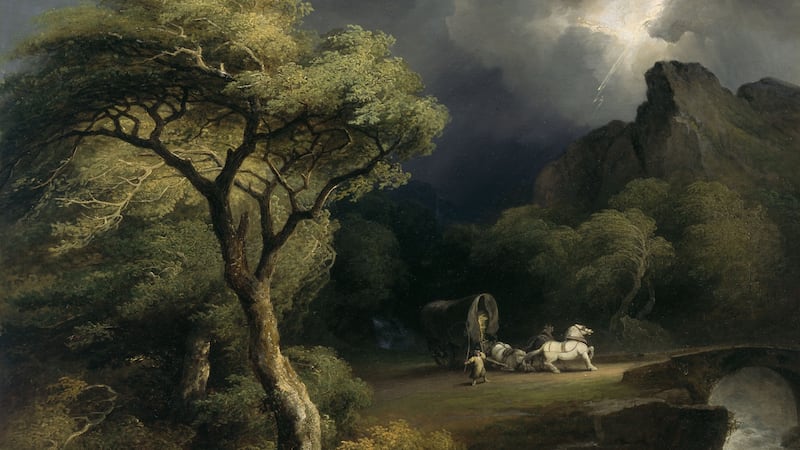James Gorry is a picture restorer and art dealer and owns the Gorry Gallery, 20 Molesworth Street, Dublin 2. He holds regular exhibitions of 18th-21st century Irish paintings; buys and sells Irish paintings on commission; sources period gilt frames; and provides a specialist service for the cleaning and restoration of oil paintings. He is the third generation to work in the family business established 120 years ago (originally in premises on Upper Ormond Quay) by his grandfather James J Gorry and has followed in the footsteps of his late father, also James.
What's your background?
I was born in Dublin and lived with my parents and sister in Grafton Street for the first 20 years of my life. We lived in a flat at the top of a building –70 steps up – overlooking the side entrance to Jammet's Restaurant on Adam Court.
It was tough on my mother having to get a pram up and down those stairs, and on the coalmen who had to carry up the sacks on their backs. My father always tipped them well.

Living in the city was wonderful and St Stephen’s Green was our garden. I went to the Theatre Royal every Sunday night. I attended Clarendon Street National School, then the Catholic University School, Leeson Street, and later the National College of Art.
I married Thérèse – who helps me to run the Gorry Gallery – and we have one son, James, who trained with us in the business but now lives in Australia, and one daughter, Aisling, who is a school teacher in Dublin.
How did you get into the business and why?
I was always drawing and painting as long as I can remember and spent a lot of my childhood in my late father's studio and gallery. I left CUS [the Catholic University School] in Leeson Street when I was 15 years old to study at night in the National College of Art. I worked by day in my father's studio on Molesworth Street as an apprentice picture restorer and art dealer.
My father had worked for 18 years as a restorer in London, having first studied at the Metropolitan School of Art in Dublin, and was an accomplished painter who exhibited at the Royal Hibernian Academy.
On his return from London in 1939, he teamed up with his father at our present premises in Molesworth Street. I have a portrait of my grandfather painted by my father in 1923.
Career highlights?
The rediscovery of Market Day, Finistère by Harry Jones Thaddeus RHA, which was exhibited at the Paris Salon in 1882, was memorable. Unseen since then, I restored it and it was shown in our 1986 exhibition, where it was purchased by the National Gallery of Ireland.
Some 28 years later in Sweden, we discovered the companion Salon exhibit by Thaddeus, The Friends of the Model – no image or description of which existed – showing the artist in his Concarneau studio painting the same model as in Market Day, Finistère. I restored it and exhibited it in our 2014 exhibition. Both works are in the National Gallery of Ireland collection.
We have repatriated many Irish works of art from around the world and we are proud of the fact that many of them are now in public institutions on view to the Irish people.
We have sold paintings to – among others – the National Gallery of Ireland, the Ulster Museum, Crawford Art Gallery in Cork, the Office of Public Works, the National Gallery of Scotland, Boston College, Ireland's Great Hunger Museum in Quinnipiac [Connecticut] and the Abbey Theatre.
What advice would you give collectors/investors?
I believe in the traditional aesthetic of collecting, rather than investing, and encourage collectors to buy paintings which give them pleasure. Real quality stands the test of time and endures beyond changing trends in taste.
Painting is a craft. The brush work should be studied carefully, learning to recognise the hand of the artist without relying on a signature.
Good condition is essential, and the original frame desirable. Social and political injustice in 19th-century Ireland was seldom portrayed by native painters but mostly by visiting artists such as the American Howard Helmick and the Scot Erskine Nicol. Their paintings of traditional Irish rural interiors – a record of the life and customs of our ancestors – can still be bought for a fraction of the cost of a minor Paul Henry painting. Topographical views – an invaluable part of our heritage – are also always sought after, regardless of who painted them, and can often be acquired for very modest sums. We'll have various examples for sale in our autumn exhibition.
What do you personally collect and why?
I collect 18th-20th century paintings, bronzes and furniture in keeping with the 1830s house which I live in.
What would you buy if money were no object?
I am happy with my modest collection and I have no desire to acquire a priceless work of art. However, if money was no object, I would set up a not-for-profit programme to support struggling Irish artists and their families.
What's your favourite work of art and why?
James Arthur O'Connor's masterpiece, A Thunderstorm: The Frightened Wagoner, 1832 [National Gallery of Ireland]. This poignant work mirrors his difficult life in his portrayal of the wagoner, frightened and alone.
This scene takes place in a wild Wicklow landscape where the artist sought solace after unsuccessful forays out of Ireland in order to earn a living. He died in London in 1841 in a state of distress, leaving his widow and family destitute. Today, his paintings are much admired and sought-after.












